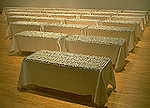ARTFORUM INTERNATIONAL
January, 2001.
Return to:
Allan McCollum.
THE EVENT:
Petrified Lightning
from Central Florida
(with supplemental
didactics). 2000.
Installation: Friedrich
Petzel Gallery.
ALLAN MCCOLLUM
FRIEDRICH PETZEL GALLERY
How does an art object encapsulate meaning? What is unique, and what is a copy? These questions have driven Allan McCollum's work since the '70s. His recent show—the result of a three-year project sponsored by the University of South Florida and undertaken with the help of a geologist and an electrical engineer from Florida University's International Lightning Research Facility at Camp Blanding—continued such investigations. The art object in this case was not a painting or sculpture but a fulgurite, a tubular specimen of petrified lightning. McCollum has appropriated the phenomenon of natural casting before, making multiples of dinosaur footprints (1994-95) and the fossilized corpse of a dog from Pompeii (ca. 1991). But by casting lightning, he experimented with embodying the instantaneous and replicating it in sculptural form.
"The Event: Petrified Lightning from Central Florida (With Supplemental Didactics)" is a scrupulously descriptive title. As it indicates, the show inquired into momentary illumination—the literal bolt from above as well as, by extension, the idea of artistic vision. McCollum proposes that such split-second events persist in the world only through tangential documentation and chance residue, what he calls "literature." Thus, the first thing one saw on entering the gallery was not the fulgurites themselves but a shelf of "Supplemental Didactics": sixty-six paper booklets, identically bound in drab tan. The words "lightning" and "fulgurite" predominated in the titles; some sounded technical, while others were drawn from the writings of Kandinsky and Darwin. There were also interviews with McCollum's project team and historical accounts of the Camp Blanding area. Information overload promptly ensued.
"Am I really expected to read these?" "Is this supposed to be boring?"
The answers were "sort of" and "yes and no." For those interested in geology or meteorology, the literature was intriguing: Who knew that lightning could instantly vitrify the mineral content of a small patch of earth, in effect casting a permanent positive of itself, uniting pure energy with pure matter and leaving behind an artifact as ghost and proof? At the same time, for aficionados of McCollum's theory of the "surrogate"—an aesthetic object that remains unique but is purged of individual identity—the "Supplemental Didactics" parsed a relationship between variety and monotony characteristic of in-depth research.
McCollum made his "assisted" fulgurites by firing rockets into thunderheads, triggering lightning bolts directed into a special barrel—in effect, forcing lightning to strike in the same place repeatedly. He then chose a single specimen and had it mass-produced by a Florida souvenir manufacturer. A five-second video sequence showed the soaring projectile and resulting bolt, while twenty tables displayed some 10,000 copies of the eight-inch-long object, made of epoxy and zircon sand. One would think that such rigorous insistence on artificiality would dampen any lingering romantic sense of the lightning bolt as untamed electricity, but subtly, the opposite happened. Ridged and twisted, laid in rows on soft cream-colored tablecloths, the whitish rods had a bony, scatological, almost erotic presence—they felt like fetishes. Because of the zircon content, they sparkled faintly. In the back room McCollum had placed six more felt-covered tables bearing stacks of multicolored booklets, the only bright spot in the visual scheme. These were bound closed, as if to admit that the profusion of supplements could not circumscribe the "event." On the other hand, the tastefully muted and precisely aligned rooms resembled some strange high-end emporium. McCollum's concept of 10,000-ness represents an overabundant but still cognizable proliferation, a human-size enormity that springs from a single source. The surprisingly direct (and optimistic) implication is that mass production—like weather patterns and metamorphic reactions—is just another system for the circulation of dynamic force.
—Frances Richard
"Selected Texts"
Return to:
MAIN